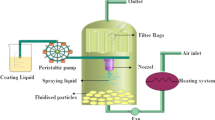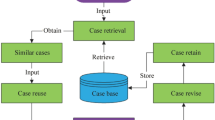Abstract
In this paper, two artificial intelligence (AI) techniques were applied to the problem of process planning in multiple-blow cold forging. Given the reduction in area of the product to be forged and the degree of formability of the material, in the first application a fuzzy logic (FL) technique was used to discriminate whether or not a cold forged product was feasible in a single blow. In the second application, a neural network (NN) architecture was used to identify the correct number of blows necessary to complete the cold forging process.
Similar content being viewed by others
References
Alberti, N., Barcellona, A., Micari, F. and Teti, R. (1995) Neural network application to cold forging, in The second AITEM (Associazione Italiana di Tecnologia Meccanican) Conference, Padua, 18-20 September, pp. 21–30.
Alberti, N., Cannizzaro, L. and Micari, F. (1991) Knowledge-based systems and FE simulations in metal forming process design: an integrated approach. Annals of CIRP, 40, 295–298.
Barcellona, A. (1993) Neural network techniques for metal forming design, in The Thirtieth International MATADOR (Machine Tool Design & Research) Conference, Manchester, 31 March-1 April. Vol. II, pp. 361–365.
Barcellona, A., Micari, F. and Salmè, F. (1993) Computer aided choice of working sequences, in The Third International Conference on Advanced Manufacturing Systems and Technology, pp. Udre, 26–27 April, Vol. II, 137-143.
Bariani, P. and Knight, W. A. (1988) Computer-aided cold forging process design: a knowledge-based system approach to forming sequence generation. Annals of CIRP, 37, 243–246.
Eshel, G., Barash, M. and Johnson, W. (1986) Rule based modelling for planning axisymmetrical deep-drawing. Journal of Mechanical Working Tecnology, 14, 1–115.
Fahlman, S. E. (1988) An empirical study of learning speed in back propagation networks, Carnegie Mellon University Technical Report, CMU-CS-88-162.
Gokler, M. I., Dean, T. A. and Knight, W. A. (1982) Computer aided sequence design for hot upset forgings, in The Twenty-Second International MATADOR (Machine Tool Design & Research) Conference, Manchester, 16-18 September, pp. 457–466.
Guley, N. and Jang, J. S. R. (1995) Fuzzy Logic TOOLBOX for Use with Matlab, The Math Works Inc., Natick, MA.
Hertz, J., Krogh, A. and Palmer, R. G (1991) Introduction to the Theory of Neural Computation, Addison-Wesley, New York.
Kaparthi, S. and Suresh, N. C. (1991) A neural network system for shape based classification and coding of rotational parts. International Journal of Production Research, 29, 1771–1784.
Masters, T. (1993) Practical Neural Network Recipes in C++, Academic Press, San Diego, CA.
Monostori, L. and Barschdorff, D. (1992) Artificial neural networks in intelligent manufacturing. Robotics and Computer-Integrated Manufacturing, 9, 421–437.
Osakada, K., Kado, T., Nakamura, T. and Mori, K. (1990) Ex pert system for cold forging process based on FEM simula tion. Annals of CIRP, 39, 249–252.
Osakada, K., Kado, T. and Yang, G. B. (1988) Application of AI-technique to process planning of cold forging. Annals of CIRP, 37, 239–242.
Osakada, K. and Yang, G. B. (1991) Neural networks for process planning of cold forging. Annals of CIRP, 40, 243–246.
Sevenler, K., Raghupathi, P. S. and Altan, T. (1987) Forming sequence design for multistage cold forging. Journal of Me chanical Working Technology, 14, 121–135.
Teti, R. and Buonadonna, P. (1994) Neural networks applications for process monitoring, in The First Conference on Applica tions of Artificial Intelligence Techniques in Engineering, Na ples, 5-7 October, pp. 89–100.
Yang, G. B. and Osakada, K. (1990) An expert system for process planning of cold forging. Advanced Technology of Plasticity, 1, 109–114.
Author information
Authors and Affiliations
Rights and permissions
About this article
Cite this article
Alberti, N., Lorenzo, R.D., Micari, F. et al. Intelligent computation techniques for process planning of cold forging. Journal of Intelligent Manufacturing 9, 353–359 (1998). https://doi.org/10.1023/A:1008982910847
Issue Date:
DOI: https://doi.org/10.1023/A:1008982910847




